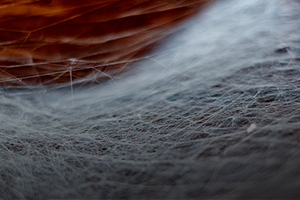Spider Silk from Bacteria

Spider silk has long been prized for being strong, flexible, biodegradable, and nontoxic. It’s widely used for sutures, bulletproof vests, and athletic gear, but is difficult to farm in large quantities. So, for decades, scientists have tried to come up with a synthetic version that mimics the real thing. Previous attempts have included transplanting spider DNA into a variety of organisms including silkworms, plants, and goats. But the best synthetic fibers have only been about half as strong as natural spider silk.
Along the way, they did learn that the secret to spider silk’s amazing strength are large protein molecules made up of long amino acid strings encoded by repetitive DNA sequences, which nature generally tries to avoid, but which spiders have found a way to preserve. So researchers engineered bacteria using modified spider DNA to produce silk protein molecules that glue together to form longer protein strings. These were ground into a powder and mixed into a solution that could be spun into fibers as strong as natural spider silk.
The current process may still be too costly for large-scale production, as it requires use of an expensive solvent. The next step will be to see if similar results can be achieved using a water-based solution.
For information: Fuzhong Zhang, Washington University, School of Engineering and Applied Science, Campus Box 11, 1 Brookings Drive, St. Louis, MO 63130; phone: 314-935-4899; email: fzhang@seas.wustl.edu; website: https://wustl.edu/ or https://engineering.wustl.edu/Pages/home.aspx